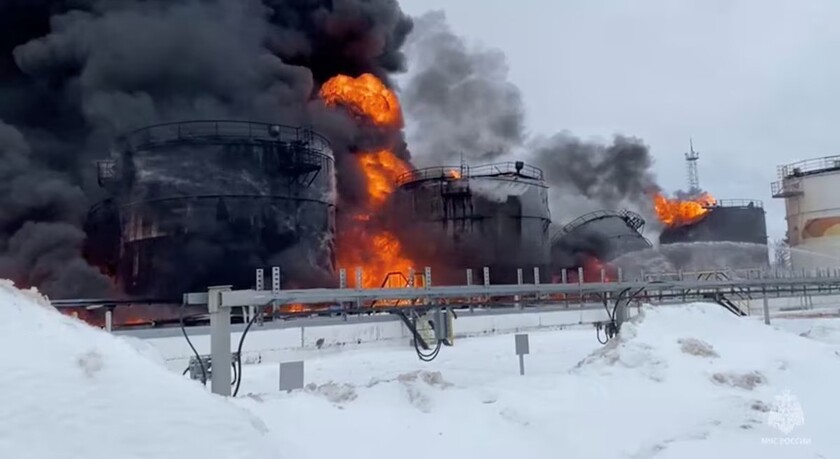The ongoing conflict between Russia and Ukraine, which began in 2014, has seen various phases of escalation. In recent years, the war has taken on a new dimension with the increased use of drone technology by Ukraine. These drone strikes, often targeted at Russian infrastructure, have sparked significant fires at energy plants across Russia, adding a new layer of complexity to an already volatile situation.
The Role of Drones in Modern Warfare
Drones, or Unmanned Aerial Vehicles (UAVs), have become a critical tool in modern warfare. Their ability to carry out precision strikes without risking human lives has made them a preferred choice for many military operations. Ukraine, understanding the strategic advantage of drones, has effectively integrated them into its military tactics. These drones are not only used for reconnaissance but also for direct attacks on enemy infrastructure.
Ukraine’s drone strikes have been aimed at disrupting Russia’s energy infrastructure, which is vital to the country’s economy and military operations. By targeting energy plants, Ukraine seeks to weaken Russia’s ability to sustain its war efforts and to send a strong message of resistance.
The Impact of Drone Strikes on Russian Energy Infrastructure
Russia’s energy infrastructure is vast and includes a network of power plants, oil refineries, and gas pipelines that are essential for both domestic consumption and export. Ukraine’s drone attacks have particularly focused on key energy plants, leading to significant fires and damage.
One of the most notable incidents occurred in [specific date or event if known], when a Ukrainian drone strike hit a major power plant in [specific location], causing a massive fire that took days to bring under control. The fire resulted in power outages across the region and highlighted the vulnerability of Russia’s energy infrastructure to aerial attacks.
These strikes have not only caused physical damage but have also created a psychological impact. The Russian population, which has largely been insulated from the direct effects of the war, is now increasingly aware of the conflict’s reach. The fires at energy plants have led to fears of more widespread attacks, leading to increased anxiety and uncertainty.
The Tactical Advantages and Limitations of Drone Warfare
The use of drones offers several tactical advantages to Ukraine. First and foremost, it allows for precision targeting, which is crucial when dealing with heavily fortified or sensitive installations like energy plants. Drones can be equipped with various types of ordnance, including explosives, which can be dropped with pinpoint accuracy.
Moreover, drones can operate in environments that would be too dangerous for manned aircraft or ground forces. This ability to operate behind enemy lines without risking lives makes drones an invaluable asset in Ukraine’s military strategy. They are also relatively inexpensive compared to traditional military aircraft, allowing Ukraine to deploy them in significant numbers without exhausting its resources.
However, drone warfare is not without its limitations. While drones can cause significant damage, they are also vulnerable to countermeasures. Russia has sophisticated air defense systems that can detect and destroy drones before they reach their targets. In addition, electronic warfare tactics, such as jamming, can disrupt the communication between the drone and its operator, rendering the drone useless.
Despite these challenges, Ukraine has managed to adapt its tactics, using swarming techniques and launching multiple drones simultaneously to overwhelm Russian defenses. This has allowed them to penetrate deep into Russian territory and strike critical infrastructure, including energy plants.
The Broader Implications of the Attacks
The fires at Russian energy plants have broader implications beyond the immediate physical damage. For one, they have exposed the vulnerability of Russia’s critical infrastructure, raising questions about the country’s ability to defend itself against future attacks. This has led to increased pressure on the Russian government to invest in better defenses and to rethink its military strategy.
Economically, the attacks have disrupted energy production and distribution, leading to potential shortages and price increases. Russia is one of the world’s largest energy producers, and any disruption to its energy supply can have ripple effects on global markets. The fires caused by the drone strikes have forced some energy plants to shut down temporarily, leading to reduced output and increased strain on the remaining facilities.
Politically, the drone strikes have emboldened Ukraine and its allies, who see the attacks as evidence that Russia is not invulnerable. This has led to increased support for Ukraine, both in terms of military aid and diplomatic backing. On the other hand, the attacks have also intensified the conflict, with Russia likely to retaliate with more force, leading to further escalation.
Russia’s Response to the Drone Attacks
In response to the drone attacks, Russia has taken several measures to bolster its defenses. These include deploying more advanced air defense systems, increasing patrols around critical infrastructure, and investing in counter-drone technology. The Russian military has also stepped up its own drone operations, using them for both defensive and offensive purposes.
In addition to military measures, Russia has also sought to address the psychological impact of the attacks. The government has launched a propaganda campaign aimed at downplaying the significance of the strikes and reassuring the population that the situation is under control. However, the continued occurrence of fires at energy plants suggests that these efforts have not been entirely successful.
The Future of Drone Warfare in the Russia-Ukraine Conflict
The use of drones in the Russia-Ukraine conflict is likely to continue and even increase in the coming years. Both sides have recognized the strategic value of drones and are investing in more advanced technologies. For Ukraine, drones offer a way to level the playing field against a larger and better-equipped adversary. For Russia, the challenge lies in finding effective countermeasures to neutralize the threat.
As the conflict drags on, the fires at Russian energy plants serve as a stark reminder of the destructive power of modern warfare. They highlight the vulnerability of critical infrastructure in a world where the battlefield is no longer confined to the front lines but extends deep into enemy territory.
Bottom Line
The fires at Russian energy plants following Ukrainian drone attacks underscore the changing nature of warfare in the 21st century. Drones have become a potent weapon in Ukraine’s arsenal, allowing it to strike at the heart of Russia’s energy infrastructure. While the immediate impact of these attacks is evident in the damage and disruption caused, the long-term implications are still unfolding. As both sides continue to adapt to this new form of warfare, the conflict is likely to become even more complex and unpredictable. The world watches as this high-stakes game of drone warfare plays out, with the potential to reshape the future of military conflicts.





